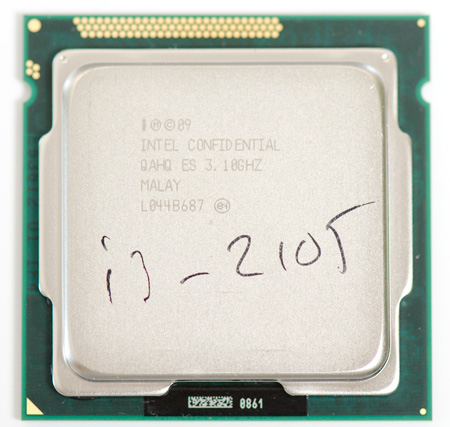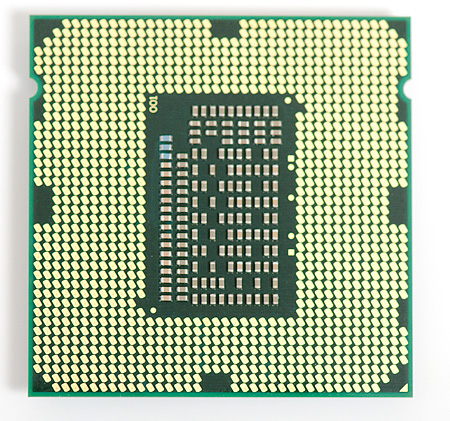The AMD A8-3850 Review: Llano on the Desktop
by Anand Lal Shimpi on June 30, 2011 3:11 AM ESTThe Direct Competitor: Intel's Core i3-2105
When Intel launched Sandy Bridge the only way you could get the faster integrated graphics option (Intel HD 3000) on the desktop was to buy one of the more expensive K-series chips. The logic didn't make a ton of sense given that lower priced systems are usually the ones that depend on integrated graphics. In the weeks before Llano's arrival however, we met a new member of the Sandy Bridge family - the Core i3-2105:

The 2105 is virtually identical to the 2100 it augments. It's still a dual-core processor (HT enabled) with a 3MB L3 cache . There's no turbo boost and you still get all of the same checkbox features (e.g. Quick Sync, VT-x, no VT-d, no AES-NI, etc...). There are only two differences between these two parts. The i3-2105 has an Intel HD Graphics 3000 core vs 2000 in the 2100, and the 2105 is priced at $134 (one dollar cheaper than the A8-3850).

It's clear that this HD 3000 equipped Core i3-2105 is intended to compete directly with the A8-3850.
The Test
The CPU tests in this review use an identical configuration to everything else in Bench (4GB memory, Intel X25-M SSD, discrete GPU etc...). The table below is for the processor graphics comparisons. All Intel HD 3000 numbers were generated using the Core i3-2105.
All discrete GPUs use our standard GPU testbed (3.33GHz Nehalem). This does prevent our usual efforts to keep our testbeds identical, however with low-end GPUs the contamination should be minimal as we’re GPU bound and then some, rather than being CPU bound.
| CPU: | AMD A8-3850 Intel Core i3-2105 |
| Motherboard: | ASUS P8Z68V-Pro (Intel Z68) ASRock A75 Extreme6 (AMD A75) |
| Chipset Drivers: | Intel 9.2.0.1025 AMD Catalyst 8.862 RC1 |
| Hard Disk: | Corsair P256 SSD (256GB) |
| Memory: | G.Skill DDR3-1866 2 x 4GB |
| Video Drivers: | AMD Catalyst 8.862 RC1 Intel 2372 |
| Desktop Resolution: | 1920 x 1200 |
| OS: | Windows 7 x64 |










99 Comments
View All Comments
BSMonitor - Thursday, June 30, 2011 - link
He is not comparing Core 2's. He is talking about Athlon 64's and Pentium M's.No benchmarks are left from that era to compare against a Pentium M. That single core Celeron with modest cache is the closest thing to it.
HW_mee - Thursday, June 30, 2011 - link
Wow, who is he? L.? he does not mention any other processor than an i3 and seems to support my opinion.I agreed to look at the dual core Celeron you linked to, implying the single core side of my post is based of people who are to lazy to upgrade, and now you start talking about a single core Celeron... I am sorry buddy, but there is a picture on the Internet that shows the only way I can reply you:
http://img26.imageshack.us/img26/7522/impliedfacep...
BSMonitor - Thursday, June 30, 2011 - link
"You guys are very demanding users and seem to expect a lot from the average user.Going the list of people i know and their computers specification shows that none of them are even close to needing an i3-2100. the computers have a mix of single core Pentium M and ULV processors in the laptops and the desktops consist of a mix of old Athlons, post socket A, and first gen core processors."
OWNED
HW_mee - Thursday, June 30, 2011 - link
I will try again, patience, patience.....I still don't know who "he" is, as you replied to one of my post and you quote me, but you refer to a different person.
I will do a long list of the mentioned systems, and describe how well they handle the owners "average" usage. Remember I am not talking about "heavy" users, which I am sure you are, but average users.
If you think this list is boring, I think it is, just skip to the bottom of this reply.
The single core parts are beginning to dwindle, but they still tug along. Most of them simply get used as the owners, including me, think they are good enough for their purpose.
The Pentium M laptops are single core, only a few of those left, mainly due to lack of driver support for the crappy Intel IGP, which laptops back then often got equipped with.
They get used for basic office task and viewing flash. I posted one guys laptop somewhere in this comment section. Multitasking on these is limited ie. grooveshark + mail + office is the limit, but they get by. The Pentium M laptops get by as the users reach their requirement limit when they have some music going and are writing a document.
The ULV's consist of a couple of SU2700 equipped Lenovo's and a bunch SU7300 laptops. The single core SU2700 is the bottom of these laptops, but they can take the punishment of the average users, again music + writing is the limit of these average users. Most of the SU7300 laptops have often been bought as I recommended them some time ago and they do everything the average user expects of them.
I own one of the SU2700 machines and it is a great road warrior, I do not perform any "heavy" work on it, as that is not the purpose of a light laptop. I can multitask on this thing, multiple FF tabs with one tab running flash video, while writing/compiling a document and mixed background task. I often push this computer to the limit and switching applications does not happen instantly. Luckily I do not consider myself an average user.
My main complaint is the crappy Intel IGP, I load up a game and everything runs fine except for stupid graphical glitches such as missing textures, badly rendered textures and flickering areas.
The Athlon 64 computers consist of one single core and a bunch of dual core. They range from socket 939 to AM3 and they work just fine. The single core is actually being used by a "heavy" user and it is running great.
All the Athlon machines are used for every tasks the owners come up with, flash, video, gaming, music etc. and they have no problems handling it.
The only complaint among the Athlon processors is that the single core Athlon user thinks the computer is slow at compiling a new kernel and can't really handle full-HD video, but that is to be expected with a processor from 2003 ;-)
The first gen core processors refers to the good old 65 nm desktop parts ie. E6300, E4400 and so forth. These processors only seem to be limited by the user, as the casual user seems unable to image a processor intensive task.
That list contains very few single core processors, mainly Pentium M models and Intel ULV, note I did not write single/dual core at the desktops. Additionally I mentioned in a different reply only the laptops fit the single core computer at an average user scenario, which you seem frightened of.
++++ interesting again +++++++
You asked why I am looking at buying a new PC when my Pentium M can handle all my tasks.
Well I am not looking for a new PC, I just keep myself up to date in the hardware world, as people I know sometimes buy a new PC and ask me what they should buy.
The performance expectation from the average user is rising slowly. Single core is being replaced by dual core and so forth, but average hardware performance is growing faster than average user expectations.
The difference in average expectation and average performance has made my "job" of recommending hardware very easy.
processors have been plenty powerful since Core 2 Duo appeared, harddrives are massive, memory dirt cheap and now games can be handled with adequate graphics on something as low as an integrated GPU :-)
Feel free to call the average user a "whoo that is cool, email.. who knew!" moron, as that is the average user. They watch youtube, download music on Itunes, write e-mail, play a few games, download adware from the Internet etc. Most of these users are happy with something as crappy as a processor with a performance level available around 2005, and even worse some of them use a 4:3 monitor and enjoy games at resolutions below full-HD.
I am tired, going to bed now and leaving for an extended weekend.
BSMonitor - Thursday, June 30, 2011 - link
You are right, I switching between them.. it's this one:http://www.anandtech.com/bench/Product/72?vs=289
BSMonitor - Thursday, June 30, 2011 - link
And YES! Compared to the stated Pentium M, etc. single core nonsense you are spewing. Convert some songs in your iTunes library, have a flash movie playing, and be working on a document in your gmail account...I'll be done with both tasks and on to the next before your gamil document even opens.
HW_mee - Thursday, June 30, 2011 - link
I hope the 60 years old thing was a bad joke, as I almost laughed.I have just finished maintenance of a laptop used by one of my friends. The laptop is a HP NC8230 from 2006 equipped with a 1.86 GHz 2nd gen Pentium M, it is being used with/for the following:
Windows 7 enterprise, paid by the employer.
Office 2010, used for writing research articles.
Firefox & IE for online video, grooveshark, casual browsing etc.
He probably has other uses, but I can't remember them right now. The only complaint he has is load times and that is caused by the ancient and slow 80 Gb 5400 rpm harddrive.
BSMonitor - Thursday, June 30, 2011 - link
And he is doing none of those things simultaneously. Guarantee it. What he is using it for is typing text.HW_mee - Thursday, June 30, 2011 - link
One last reply, yawn.No he does not use windows and office at the same time..... idiot, do you want the facepalm link again?
It is not my computer, but I sometimes borrow it when I visit him.
I know that it usually has a word document running, 3 to 5 tabs open in FF one with Grooveshark, Outlook open with some blabla, mail, some Windows gadgets on the desktop and Sophos antivirus somewhere in the background.
The computer does get slow when Sophos starts crunching on the harddrive. Antivirus programs is one of the commonly known reasons to go for dual core and a fast harddrive.
If he starts watching flash video he stops Grooveshark, as he wants to listen to the video, but the rest of the programs remains open. Microsoft have actually implemented a great scheduler in Windows 7, as long as you have enough memory, even a single core processor can pull through a lot.
Gigantopithecus - Thursday, June 30, 2011 - link
I agree with your post almost entirely. My only disagreement is that I know very few people still using single core CPUs like the Pentium M and S754/939 Athlon Is. Those CPUs are no longer sufficient for basic tasks. However, they're also OLD. Any dual-core CPU aside from the Pentium D abominations and the Atom dual cores - and I include the first-gen Athlon X2s - is sufficient for basic usage.Your points that this platform is targeted more at OEMs than enthusiast DIYers and that SSDs and dGPUs being more important than CPUs to overall system quality are, imho, very poignant.